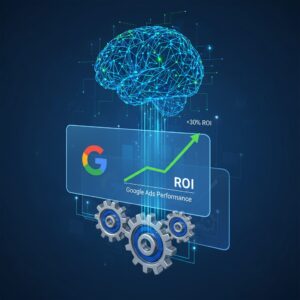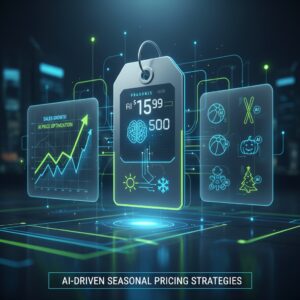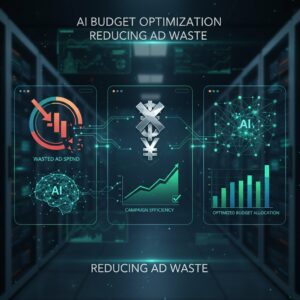
I’ve spent over two decades helping small businesses grow, and I can tell you this: most of them waste money on Google Ads. Not because they’re incompetent, but because managing campaigns manually is nearly impossible at scale.
You’re juggling keyword bids, ad copy testing, audience targeting, and budget allocation across multiple campaigns. Meanwhile, your competitors are using AI to automate these decisions in real time.
The gap is widening fast.
Small businesses that adopt AI-powered campaign management are seeing 30 to 40 percent improvements in ROI within the first quarter. Those who don’t are falling behind, paying more per click while converting fewer customers.
Let me show you exactly how AI transforms Google Ads performance and why you need to implement it now.
Why Manual Campaign Management Fails
You log into your Google Ads account at 9 AM. You check yesterday’s performance, adjust a few bids, pause underperforming keywords, and increase budget on campaigns that converted well.
Sounds reasonable, right?
Here’s the problem: the data you’re analyzing is already outdated. Consumer behavior shifts hourly. Your competitors adjusted their bids while you were asleep. Market conditions changed overnight.
Manual management creates lag time between market shifts and your response.
I worked with a retail client last year who was spending $8,000 monthly on Google Ads. They checked their campaigns twice daily and made thoughtful adjustments. Their conversion rate was stuck at 2.3 percent.
We implemented AI campaign management in January. By March, their conversion rate hit 3.8 percent with the same budget. They didn’t work harder. The AI simply made better decisions faster.
Manual management also forces you to rely on averages. You set bids based on average performance across days, times, and audience segments. But averages hide opportunities.
AI identifies patterns you cannot see. It knows that mobile users searching at 7 PM on Thursdays convert 40 percent better than your average. It adjusts bids automatically to capture that traffic.
You cannot compete with that level of precision manually. You don’t have the time, and frankly, your brain isn’t wired to process thousands of data points simultaneously.
The businesses still managing campaigns manually are bleeding money. Every day they wait costs them conversions they’ll never recover.
How AI Optimizes Campaign Performance
AI-powered campaign management works by continuously analyzing performance data and making micro-adjustments across your entire account.
Let me break down the specific ways AI improves your results.
First, AI handles bid optimization in real time. It evaluates every auction individually, considering device type, location, time of day, user behavior, and dozens of other signals. It then calculates the optimal bid to maximize your target metric, whether that’s conversions, revenue, or target ROAS.
Google’s Smart Bidding uses machine learning to predict conversion likelihood for each search query. It processes signals that manual bidders never consider: browser type, operating system, previous site interactions, and more.
I implemented this for a service business spending $3,500 monthly. Their cost per lead dropped from $127 to $89 within six weeks. Same keywords, same ad copy. Better bidding decisions.
Second, AI improves audience targeting through predictive analysis. It identifies which audience segments are most likely to convert and automatically adjusts targeting to reach them more aggressively.
You might think your best customers are 35 to 50 year old homeowners. AI might discover that 28 to 34 year old renters actually convert at twice the rate and have higher lifetime value. It shifts budget accordingly without you lifting a finger.
Third, AI optimizes ad creative performance through dynamic testing. It rotates ad variations, analyzes performance across different audience segments, and serves the highest-performing creative to each user.
This goes beyond simple A/B testing. AI tests multiple headlines, descriptions, and call-to-action combinations simultaneously, learning which combinations work best for different search intents.
A legal services client I worked with had three ad variations they’d been running for months. We implemented responsive search ads with AI optimization. Click-through rate improved 26 percent in the first month as AI learned which combinations resonated with different searchers.
Fourth, AI manages budget allocation across campaigns. It identifies which campaigns, ad groups, and keywords deliver the best return and automatically shifts budget toward top performers.
You might manually reallocate budget once a week. AI does it constantly, capturing opportunities the moment they appear and pulling back spend when performance drops.
Fifth, AI detects and responds to external factors affecting performance. Seasonal trends, competitor activity, market shifts, even weather patterns can impact campaign performance. AI recognizes these patterns and adjusts strategy accordingly.
I watched AI-powered campaigns automatically reduce bids during a competitor’s aggressive promotion, then increase them immediately when the promotion ended. A manual manager would have lost thousands before noticing the pattern.
The compound effect of these optimizations is substantial. Each improvement might seem small individually, but together they create dramatic ROI improvements.
Implementation Strategy for Small Businesses
You don’t need a massive budget to benefit from AI campaign management. You need a clear implementation strategy.
Start with Google’s built-in AI tools. Smart Bidding strategies like Target CPA and Target ROAS are free and require minimal setup. They work well for accounts spending as little as $1,000 monthly, provided you have sufficient conversion data.
You need at least 30 conversions in the past 30 days for Smart Bidding to work effectively. If you’re below that threshold, focus first on increasing traffic or improving conversion rate through landing page optimization.
Enable responsive search ads across all campaigns. Upload multiple headlines and descriptions. Let Google’s AI determine the best combinations for each searcher.
Set up conversion tracking properly before implementing AI tools. AI optimizes toward the goals you measure. If your tracking is incomplete or inaccurate, AI will optimize toward the wrong outcomes.
I’ve seen businesses implement Smart Bidding while tracking only phone calls, missing form submissions entirely. The AI drove fewer calls because it wasn’t optimizing for total conversions. Fix your measurement first.
Consider third-party AI platforms for advanced features. Tools like Optmyzr, Adalysis, and WordStream offer capabilities beyond Google’s native features, including cross-platform optimization and advanced reporting.
These platforms typically cost $200 to $500 monthly but can manage campaigns more efficiently than hiring an agency. For businesses spending $5,000 or more monthly on ads, the ROI usually justifies the investment.
Test AI tools incrementally rather than overhauling everything at once. Apply Smart Bidding to your top-performing campaign first. Monitor results for two weeks. If performance improves or remains stable, expand to other campaigns.
This approach minimizes risk while letting you learn how AI affects your specific account.
Set appropriate conversion windows and attribution models. AI needs accurate data about which clicks lead to conversions. If your sales cycle is 14 days, don’t use a 7-day conversion window or AI will undervalue top-of-funnel keywords.
Monitor AI performance weekly initially, then bi-weekly once you’re confident in the results. AI doesn’t need daily management, but you should verify it’s optimizing toward your business goals, not just Google’s metrics.
Watch for AI optimizing toward easy conversions rather than valuable ones. If you sell both $50 and $500 products, AI might drive traffic toward cheaper items because they convert more easily. Use value-based bidding to guide AI toward higher-value conversions.
Remember that AI improves over time as it gathers more data. Performance in week one will be worse than performance in week eight. Give it time to learn before judging results.
The businesses winning with Google Ads today aren’t working harder than you. They’re leveraging AI to make better decisions faster. You can do the same starting today.
Your competitors already are.
Please check our Business Tips https://thoughts.business/category/business-tips/
Please check our partner site – Why Invest? https://whyinvest.info/





